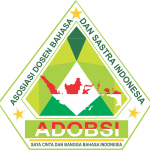MITOS LORELEI DARI WAKTU KE WAKTU: KAJIAN FEMINISME EKSISTENSIALISME PADA TIGA LIRIK LORELEI TAHUN 1823, 1981, DAN 2013
Abstract
This study analised the theme of the myth contained in three lyrics of Lorelei from three different times. Lorelei is a mythical woman whose name is taken from a cliff on the Rhine. This research will refer to the relationship between women (Lorelei) and male figures and the relation will be analyzed through the perspective of existentialist feminism using two main concepts, Men as Subjects and Women as Other Figures. The author chose the Lorelei-lyrics from three different time, Heinrich Heine's Lorelei (1823), Dschinghis Khan's Loreley (1981), and Faun's Lore Lay (2013) to show the Lorelei myth displayed in different era. Through the study of existentialism feminism, it can be seen that Lorelei is still described as the object which is marginalized by the strong myth of the fame fatale. Although the depictions of Lorelei's subjectivity can be found in some parts of the lyrics by Dchingis Khan (1981) and Faun (2013), but those depictions are still very vague.
Keywords: Myth, Lorelei, Existentialism Feminism, Men, Women
Keywords
Full Text:
PDFReferences
Aryaguna, Nandi Wardhana Manggala. (2012). “Lorelei: Citra Perempuan dari Sudut Pandang Laki-laki dalam Tiga Puisi Masa Romantik karya Clemens Brentano, Otto Heinrich Graf von Loeben, dan Heinrich Heine”. Skripsi, Universitas Indonesia
Beauvoir, Simone de. (1956). The Second Sex. London: Lowe and Brydone and bound by A.W. Bain and Co
Bertens, K. (1987). Fenomenologi Eksistensial. Jakarta: PT Gramedia Pustaka Utama.
Crozier, W. Ray. (2016). “The Blush: Literary and Psychological Perspectives”, Journal for the Theory of Social Behaviour, Vol. 46, No. 4. 2016, hlm. 502-515, DOI: 10.1111/jtsb.12105
Dagun, Save M. (1990). Filsafat Eksistensialisme. Jakarta: Rineka Cipta.
Djajanegara, Soenarjati. (2010). Bahasa, Sastra, dan Wanita. Jakarta: Penaku
Djajanegara, Soenarjati. (2000). Kritik Sastra Feminis: Sebuah Pengantar. Jakarta: PT Gramedia Pustaka Utama
Diana, Jumiati. 2018. “Citra Sosial Perempuan dalam Cerpen Kartini Karya Putu Wijaya: Tinjauan Kritik Sastra Feminis”, Jurnal Pena Indonesia, Jurnal Bahasa Indonesia, Sastra, dan Pengajarannya, Vol. 4 No. 1 Maret 2018, hlm. 79-96
Esser, Rolf. 2007. Das groβe Arbeitsbuch Literaturunterricht – Lyrik, Epik, Dramatik. Verlag an der Ruhr
Gage, John. (1990). ”Color in Western Art: an issue?”, The Art Buletin Vol. 72, No 4. Desember 1990, hlm. 518-541
Gemberling, Kyra. 2014. “Femine Agendas: the Historical evolution of feminism as reflected in the content of American women magazines”, The Elon Journal of Undergraduate Research in Communications, Vol. 2, No. 2, fall 2014, hlm. 51-58
Marquaβ, Reinhard. (1997). Duden Abiturhilfen Erzählende Prosatexteanalysieren. Mannheim: Dudenverlag
Oelze, Sabine (2013). Der Rhein – Fluss der Romantik. Diakses dari https://www.dw.com/de/der-rhein-fluss-der-romantik/a-16966600 pada 6 Mei 2017.
Siwi Handayani, Christina Gadis Arivia. Haryatmoko. Robertus Robet. (2013). “Subjek yang Dikekang, Pengantar ke Pemikiran Julia Kristeva, Simone de Bauvoir, Michel Foucault, Jacques Lacan. Jakarta; Komunitas Salihara- Hivos.
Siswantoro. (2010). Metode Penelitian Sastra – Analisis Struktur Puisi. Yogyakarta: Pustaka Pelajar
Tseelon, Efrat. 1995. The Little Mermaid: a icon women’s in condotions partiarchy, and human condition of castration”, The International Journal of Psychoanalysis, Vol 76 ( Pt 5)(5):1017-3
Refbacks
- There are currently no refbacks.






